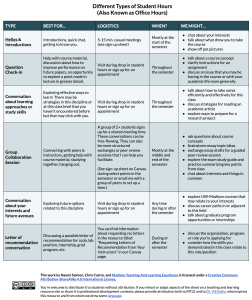Supplemental Resources: Supporting Student Learning
Improving Office Hours
Office hours conversations can be an asset for students and faculty alike. By meeting with faculty or TAs one-on-one, students get support for their individual learning needs. Such discussions help instructors understand ways to better support a wider range of learners during the semester—for instance, by adapting lecture content or clarifying an assignment prompt.
However, many students come to college not knowing exactly what office hours are for, and this ambiguity is intensified by the fact that different instructors often have markedly different understandings about appropriate questions for office hours.[1] (For example, some instructors welcome conversations about how a student might improve an in-progress essay draft. Other instructors feel that it should be self-evident to students that they won’t discuss student work before the due date! What’s a student to do?)
One way to reduce ambiguity, expand students’ perceptions of office hours’ usefulness, and convey a supportive environment is to tell students how they can use office hours and describe what different office hours conversations might look like in your class. Not only can this increase the likelihood that students will attend office hours, but it can also promote a more equitable classroom environment.[2]
Demystifying Office Hours From Day One – A “Tasting Menu” Approach

Consider outlining the different purposes of office hours at the start of the semester. One way to do this is to share an “office hours tasting menu” handout with students.
If you’d like, you should feel free to condense and adapt the following handout for your students. You might also include a description of office hours types in your syllabus and/or in a Module 0 introductory unit in Canvas.
We’ve embedded a preview of this handout below, but you can also view and download the document by clicking on this link to the original Office Hours Types Googledoc or this Office Hours Types PDF.
Intermittent Descriptive Reminders
When you’re reminding your students about the time and location of your next office hours (or the opportunity to make an appointment!), take an extra moment to describe one or two discussions or activities that office hours might involve. Vary your examples over the course of the semester.
For example:
- “I’ll be holding digital office hours this afternoon from 4-6. We have a paper coming up—I’m happy to help you brainstorm about research topics if you’re feeling stuck.”
- “Some of you may be feeling anxiety about our midterm in two weeks, especially if you’re also preparing for midterms in other courses. I know that when I was in college, it took me a while to develop effective study skills in this field. I’m happy to talk about exam preparation strategies during office hours.”[3]
Not This—But That
It’s useful to set boundaries around what you can and can’t help with during office hours. If you’re describing something you can’t do, provide an example of a related need you can discuss with students. Doing so can communicate a supportive environment while also maintaining the boundaries you feel are appropriate.
For example:
- “While I’m not able to read full drafts of your essays before the due date, I’m happy to talk with you about your thesis statement and key points.”
- “I make it a policy not to discuss exam scores within 24 hours of returning midterms. However, after 24 hours, I’m happy to meet during office hours to discuss your work. During this conversation, we can look for ways that you can prepare for similar questions to appear on our cumulative final.”
- Smith, M., Yujie Chen, Berndtson, R., Burson, K. M., & Griffin, W. (2017). “Office Hours are Kind of Weird”: Reclaiming a Resource to Foster Student-Faculty Interaction. InSight: A Journal of Scholarly Teaching, 12, 14–29. https://doi.org/10.46504/12201701sm ↵
- Dr. Viji Sathy highlights the role of office hours in promoting inclusion in her page on communicating about office hours, which also includes the descriptive infographic she uses for her own students. ↵
- Dunlosky et al. explain that many of the most popular study strategies—(highlighting, rereading, etc.)—are not as effective as other forms of studying—(practice testing, distributed practice, elaborative interrogation, etc.). Sometimes it can be helpful to chat with students about what they typically do to prepare for exams and how they might approach the process productively. See Dunlosky, J., Rawson, K. A., Marsh, E. J., Nathan, M. J., & Willingham, D. T. (2013). Improving Students’ Learning With Effective Learning Techniques: Promising Directions From Cognitive and Educational Psychology. Psychological Science in the Public Interest, 14(1), 4–58. https://doi.org/10.1177/1529100612453266 . ↵

